Here’s the best way to learn kanji
Learn all about kanji – including 20 basic kanji and a handy trick for memorizing new characters.
I want to learn...
If you’re a beginner to the world of kanji, it can seem intimidating. But we’re here to show you that, yes, you can learn kanji – and you might even have some fun doing it.
But first, what is “kanji”?
Kanji is one of the three Japanese alphabets, or writing systems. It’s usually the third system people learn, after hiragana and then katakana.
That’s because kanji is unique among the writing systems. Whereas the other two, hiragana and katakana, are more like alphabets, kanji is made up of thousands of characters, each of which represents a complete word or idea.
But don’t let that scare you! Think of learning kanji more like learning vocabulary than trying to memorize images.
To read basic Japanese, you’ll need roughly 1,000 kanji under your belt (1,026 would put you around the level of a Japanese 6th grader, while a little over 2,000 puts you at the recommended fluency level of a Japanese adult). But think about what goes into that 1,000 – words like one, two, three, stop, go, money, and tea. You can start to see how you’ll naturally start to learn them just by seeing them over and over in the process of learning Japanese.
Wait a tick! So is it kanji, or kanji characters, or… kanjis?
Finding the use of the word “kanji” confusing? You’re not alone! Kanji is both a single noun that refers to the writing system (as in “you should learn kanji”) and as a plural noun to refer to the characters themselves (as in, “how am I going to remember all these kanji?”).
Of course, learning to read kanji takes work. It can be difficult. But learning to speak any new language takes work – and we have a few tricks up our sleeve to make memorization easier and faster.
Before we get into the tricks, though, let’s take a look at some kanji, just so you know exactly what we’re talking about.
A closer look at 20 basic kanji
| 人 | 女 | 父 | 子 |
|---|---|---|---|
| Person, people (“hito”, “jin”) | Woman (“jo”, “on’na”) | Father (“chichi”) | Child (“shi”, “ko”) |
| 一 | 二 | 三 | 四 |
| One (“ichi”) | Two (“ni”) | Three (“san”) | Four (“yon”) |
| 山 | 川 | 火 | 風 |
| Mountain (“san”, “yama”) | River (“kawa”) | Fire (“hi”, “ka”) | Wind (“kaze”) |
| 木 | 森 | 鳥 | 魚 |
| Tree (“ki”, “moku”) | Woods, large forest (“mori”) | Bird (“tori”) | Fish (“sakana”) |
| 口 | 入口 | 出 | 出口 |
| Mouth (“ku”, “kuchi”) | Entrance (“iriguchi”) | Out (“shutsu”) | Exit (“deguchi”) |
Learn kanji the fun way with Busuu
Learn to read, write, and speak Japanese with exercises, neat tricks, and the guidance of native speakers – all on the Busuu app.
Onyomi, kunyomi and the history of kanji
You might notice that there are two different readings listed for some of the kanji you see above. These are called onyomi and kunyomi.
For more on that, let’s turn it over to Busuu’s resident Japanese expert:
“To better understand kanji, you’ll need a little bit of history.
Kanji was brought to Japan from China – some think as early as the first century C.E. At the time, there was no written language in Japan, so, eventually, the Japanese started to record Japanese words using kanji.
That means that the kanji took on two meanings and sounds – the original Chinese one, and new Japanese words and sounds.
Over time, Japanese kanji have deviated more from the meaning of their Chinese roots, but still often have more than one sound to reflect the Japanese word and the Chinese sound brought with the character. The Japanese sound is known as ‘kunyomi’ and the Chinese sound is known as ‘onyomi’. So in a way, each Japanese kanji carries the history of the character itself.”
In short? Learning kanji often means learning multiple ways of reading and vocabulary to go with a particular kanji. If all that sounds intimidating and new, think of it like learning different words that look the same but mean different things. Bat. Lie. Fair. We learn all the possible meanings, then figure out what’s meant based on context. Not so scary, right?
The best way to learn kanji: 2 simple tricks
Ok, now you’ve got a basic feel for what we mean when we say kanji. But how in the world do you memorize over 1000 of them?
Well, you study. But don’t worry. Like we said – we have a couple of tricks up our sleeve.
1. Use mnemonics to memorize kanji
To get started, you’ll want to do a little memorization of basic kanji to start getting a feel for them. To do that, we just love mnemonics. It might feel a little silly at first, but trust us – it really works.

A mnemonic device is any device we use to memorize something, from an image or word association to acronyms and more. Here at Busuu, our language experts prefer to use images. After all, every kanji has a shape – which means every kanji has a shape we can play with to help us remember.
To get you started, here are our favorite mnemonics for a few more basic kanji characters:
- 百 ひゃく “hyaku” 100
Looks like the number 100 turned on its side.
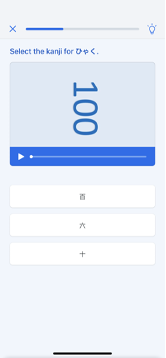
- 万 まん “man” 10,000
Looks like a person running.
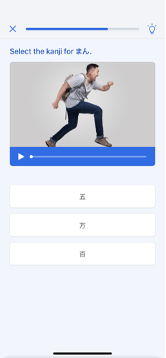
- 聞 き(く) “ki(ku)” To listen
Looks like a person trying to hear better by cupping their ears.
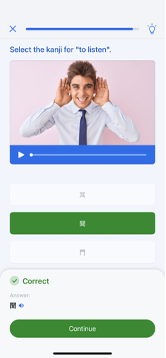
- 行 い(く) “i(ku)” To go
Looks like two people walking together with one wearing a hat.
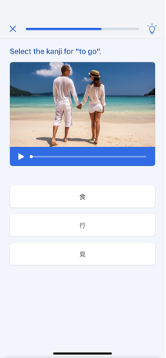
- 見 み(る) “mi(ru)” To see
Looks like an eyeball with legs.
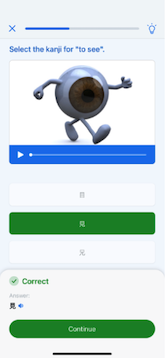
Something kind of cool
You might notice that some kanji really seem to look like what they mean. That’s not entirely a coincidence – it’s believed that some of the earliest kanji were pictograms – drawings of what they represented. Our personal favorite is the kanji for barbecued meat: 焼肉. Look closely: doesn’t it look like a person at a grill with a plate of meat?
2. Use radicals to demystify kanji
Once you’ve gotten used to the look and feel of kanji, there’s another great trick you can use that’ll help you start remembering new kanji when you see them: learning radicals.
Radicals are the pieces that make up kanji characters, and they’re sort of like the alphabet of kanji. They have names that usually match up with what they mean when they’re alone, like person (人), sun (日), and mouth (口) – though they don’t all form words on their own. The radical ‘lid’ (⼇) for example is not the kanji for the word ‘lid’ – although you will see it inside if you look: 蓋.
And here’s what’s really neat: radicals often bring some of their own meaning to the words they appear inside.
● 言 (words, to speak, say) + 寺 (temple) = 詩 (poetry, poem)
● 扌(hand) + 寺 (temple) = 持 (to hold)
● 日 (sun) + 寺 (temple) = 時 (time)
● 人 (person) +寺 (temple) = 侍 person who serves the high class people → samurai
● 目 (eye) + 亡 (death) =盲 (blind)
● 日 (sun) + 月 (moon) = 明 (bright)
● 火 (fire) + 丁 (street) = 灯 (lamp)
See? You can learn kanji
And Busuu can help. Learn kanji, radicals, and so much more with our award-winning online Japanese course.
You might also like…
Beginner’s guide to the Japanese alphabet
Learning Hiragana: why the best way is with mnemonics
Should you learn romaji? What it is and why you don't need it
Thank you in Japanese
Hello in Japanese
15 essential Japanese particles and what they mean
Japanese honorifics: the basics
Time in Japanese
Japanese pronunciation